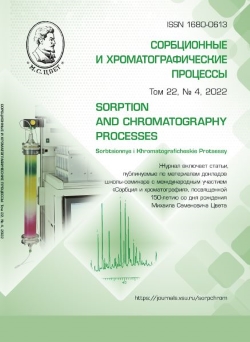Adsorption of methane on a nanoporous carbon-based material
Abstract
Along with the global transition to sustainable low-carbon economy, two basic low-carbon technologies, namely the storage and capture of methane, face the same problem - a lack of effective adsorbents. Carbon-based materials can be effective for the storage of adsorbed gases due to their high values of specific surface, porosity, and adjustable structure of pores.
In our study, a nanoporous carbon-based material (NCBM12) was synthesised by means of chemical activation (KOH) of a polymer precursor in order to obtain an effective adsorbent for methane. The synthesised NCBM had high values of specific surface according to BET (2722 m2/g), the total volume of pores (1.08 cm3/g) and the volume of micropores (0.89 cm3/g). The synthesised NCBM was used to study the adsorption of methane at temperatures of 298.15, 313.15, 323.15 К and the pressure of 100 bar. The maximum adsorption of methane on the NCBM was 14.32 mmol/g at 298.15 К and 100 bar.
The adsorption isotherms of methane on the NCBM were analysed using the Langmuir and Freundlich models based on the adsorption experiments conducted within the temperature range of 298.15-323.15 К. The results demonstrated that the adsorption of methane on the NCBM within the temperature and pressure range considered in the study corresponded to the Langmuir adsorption isotherm, which is confirmed by good correlation (R2=0.99). The mean relative deviation of the experimental results and the results obtained using the Langmuir was below 10%.
The adsorption capacity of the NCBM for methane decreases with an increase in the temperature. At 298.15 К, the isosteric heat of adsorption is ~15 kJ/mol, which corresponds to the physical adsorption of methane. The isosteric heat of adsorption decreases with an increase in the degree of filling of the NCBM surface with the adsorbate (methane). Apparently, this is accounted for by the energy inhomogeneity of the surface of the adsorbent towards methane. Methane molecules initially occupy centres with highest absorption energies (micropores). Further increase in adsorption and decrease in heat are explained by the fact that pores with lower energies are filled, as well as by the growth in repulsion energy.
Adsorption isotherms and thermodynamic parameters described in the article can be used to design adsorption-based systems for gas storage.
Downloads
References
Shemshad J., Aminossadati S.M., Kizil M.S. A review of developments in near infrared methane detection based on tunable diode laser. Sensors and Actuators B: Chemical. 2012; 171: 77-92. https://doi.org/10.1016/j.snb.2012.06.018
Massie C., Stewart G., McGregor G., Gilchrist J.R. Design of a portable optical sensor for methane gas detection. Sens. Actuators B-Chem. 2006; 113: 830-836. https://doi.org/10.1016/j.snb.2005.03.105
Ceyhan A.A., Sahin O., Baytar O., Saka C. Surface and porous characterization of activated carbon prepared from pyrolysis of bio-mass by two-stage procedure at low activation temperature and it’s the adsorption of iodine. J Anal Appl Pyrolysis. 2013; 104: 378-383. https://doi.org/10.1016/j.jaap.2013.06.009
Hadoun H., Sadaoui Z., Souami N., Sahel D., Toumert I. Characterization of mesoporous carbon prepared from date stems by H3PO4 chemical activation. Appl Surf Sci. 2013; 280: 1-7. https://doi.org/10.1016/j.apsusc.2013.04.054
Toprak A., Kopac T. Surface and hydro-gen sorption characteristics of various activated carbons developed from rat coal mine (Zonguldak) and anthracite. Chin. J. Chem. Eng. 2011; 19: 931-937. https://doi.org/10.1016/S1004-9541(11)60074-8
Memetova A., Tyagi I., Suhas R. R. K., Memetov N., Zelenin A., Stolyarov R., Babkin A., Yagubov V., Burmistrov I., Tkachev A., Bogoslovskiy V., Shigabaeva G., Galunin E., High-Density Nanoporous Carbon Materials as Storage Material for Methane: A value added solution. Chemical Engineering Journal. 2022; 134608. https://doi.org/10.1016/j.cej.2022.134608
Langmuir I.J., The adsorption of gases on plane surfaces of glass, mica and platinum, J Am Chem Soc,. 1918, Vol.40 (9), pp. 1361-1403. https://doi.org/10.1021/ja02242a004
Freundlich M.F. Over the adsorption in solution. J. Phys. Chem. 1906; 57: 355-471.
Sing K.S.W., Everett D.H., Haul R.A.W., Moscou L., Pierotti R.A., Rouquerol J. Reporting physisorption data for gas/solid systems with special reference to the determination of surface area and porosity. Pure Appl Chem. 1985; 57: 603-619. https://doi.org/10.1351/pac198557040603
Erdogan F.O., Kopac T. Adsorption behavior of alcohol vapors on Zonguldak-Karadon coal derived porous carbons. Energy Sources, Part A: Recovery, Utilization, and Environmental Effects. 2019; 1-22. https://doi.org/10.1080/15567036.2019.1666191
Oguz E.F. A comparative study on me-thane adsorption onto various adsorbents including activated carbons, zeolites, MWCNT, and MCM-41. International Journal of Coal Preparation and Utilization. 2020; 1-21. https://doi.org/10.1080/19392699.2020.1798941







